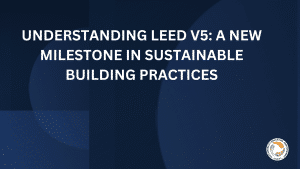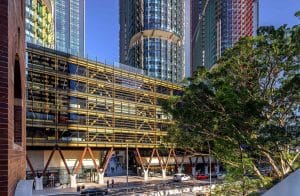We all know that buildings have the ability to improve or deteriorate the health of their inhabitants. There are several ‘sick’ buildings whose occupants complain of illness and poor health due to mold, dampness and other less than healthy conditions. On the other hand, buildings with good ventilation, air flow, indoor plants, eco-friendly designing etc generally have happier and healthier workers and residents.
How important it is for a building to support and enhance the health of its occupants can be judged from the fact that Americans spend nearly 90% of their time indoors. Despite this mind-boggling statistic, people continue to breathe in unhealthy air indoors, which is on an average two to five times more polluted than outside air, because their building design and features are such that they do not advance the health and overall well being of its inhabitants.
However, the good news is that the focus on improving human health and wellness in the built environment is on the rise worldwide. This is why GBCI developed the WELL AP credential in collaboration with the International WELL Building Institute (IWBI), a public benefit corporation whose mission is to improve human health and well-being through the built environment.
What is the WELL Building Standard?
Launched in 2014 after six years of research and development, the WELL Building Standard is a performance-based system for measuring, certifying, and monitoring features of the built environment that impact human health and wellbeing. It is the world’s first building certification that focuses exclusively on human health and wellness.
The Standard sets performance requirements in seven concepts relevant to occupant health in the built environment – air, water, nourishment, light, fitness, comfort and mind. All these concepts are based on medical research concerning how environments affect human health.
In short, WELL is all about buildings and communities that help people thrive.
The WELL Building Standard is revolutionizing the way people think about buildings. It explores how design, operations and behaviors within the places where we live, work, learn and play can be optimized to advance human health and well being. Covering the above mentioned seven core concepts of health and hundreds of features, WELL is a flexible building standard and represents the future of design.
WELL is managed and administered by the International WELL Building Institute (IWBI). It is a public benefit corporation founded by former Wall Street veteran Paul Scalia and its mission is to improve human health and wellbeing through the built environment.
It should be noted that WELL is third-party certified by Green Business Certification Inc. (GBCI), which administers the Leadership in Energy and Environmental Design (LEED) program.
Further, WELL works in conjunction with global green building rating systems like LEED, BREEAM, GreenStar and Living Building Challenge to enhance building performance for human health and our environment.
The Seven Concepts of WELL Building Standard
WELL Building Standard measures the attributes of buildings that impact occupant health by looking at seven factors, or Core Concepts:
- Air: Optimize and achieve indoor air quality. Strategies include removal of airborne contaminants, prevention and purification.
- Water: Optimize water quality while promoting accessibility. Strategies include removal of contaminants through filtration and treatment, and strategic placement.
- Nourishment: Encourage healthy eating habits by providing occupants with healthier food choices, behavioral cues, and knowledge about nutrient quality.
- Light: Minimize disruption to the body’s circadian rhythm. Requirements for window performance and design, light output and lighting controls, and task-appropriate illumination levels are included to improve energy, mood and productivity.
- Fitness: Utilize building design technologies and knowledge-based strategies to encourage physical activity. Requirements are designed to provide numerous opportunities for activity and exertion, enabling occupants to accommodate fitness regimens within their daily schedule.
- Comfort: Create an indoor environment that is distraction-free, productive, and soothing. Solutions include design standards and recommendations, thermal and acoustic controllability, and policy implementation covering acoustic and thermal parameters that are known sources of discomfort.
- Mind: Support mental and emotional health, providing the occupant with regular feedback and knowledge about their environment through design elements, relaxation spaces, and state-of-the-art technology.
How does WELL support employee health in corporate buildings?
Organizations with healthier employees can not only increase productivity and retention, but also reduce health insurance costs for individuals, as well as their businesses. Listed below are five ways in which WELL can positively impact the overall health and well being of employees in the built environment.
Support mental health
There are number of ways that a well-designed office can improve an employee’s mental health from encouraging healthy sleep habits to providing connections and access to nature. Flexibility is another important element. Research has shown a connection between job satisfaction, as well as a group’s cohesiveness, to the presence of varied spaces that support different work-styles. The WELL Standard says work environments should offer spaces to work, focus, collaborate and rest. This means providing a combination of quiet zones, collaborative spaces and multi-functional workstations for team members.
Reevaluate lighting
Effective lighting design, offering access to daylight for our bodies’ circadian rhythms, workstations positioned to reduce glare and daylight modeling are just a few of the thirteen ways the WELL Standard addresses light. Natural daylight and access to views of nature are critical components of supporting employees’ overall well-being and healthy sleep habits.
Reduce distractions
Internal noise can lead to decreased productivity, particularly in open offices where distractions and interruptions are frequent. However, there are a large number of acoustic solutions and design practices companies can use to ensure each employee has a comfortable place to focus. Impact reducing flooring, sound barriers, sound masking and sound reducing surfaces can help companies enhance their teams’ performance and ability to focus.
Foster healthy nutrition
Eating habits are often influenced and reinforced through cues in our environment. Currently, only 8 percent of people consume the recommended four servings of fruit per day, and 6 percent consume the recommended five servings of vegetables per day. Providing access to healthy foods, like fruits and vegetables and communal cooking areas can foster healthier decision making. WELL also suggests the reconfiguration of dining environments to increase the appeal and visibility of nutritious foods. Providing convenient bottle refilling stations with filtered water and signage to encourage drinking water reminds associates to stay hydrated.
Start moving
Encourage employees to take the stairs by making stairwells open and accessible. Another method to incentivize movement is to add physical activity spaces or make changes to the building’s exterior, such as designing cyclist and pedestrian-friendly environments. Organizations can also supplement gym memberships and fitness programs to encourage an active lifestyle outside the office.
WELL Certification Guide
Spaces can become WELL certified by achieving a defined score in each of the above mentioned seven ‘Core Concept’ categories. WELL certification includes the submission of project documentation and onsite audit, which can result in the award of a Silver, Gold or Platinum standard.
Performance verification, which is an onsite audit and visual assessment, occurs at least one-month post-occupancy and includes testing of the performance metrics and spot checks of all applicable features. Further, WELL requires projects to conduct an occupant survey to gather feedback on a variety of topics. This allows organizations to gain insight into areas that require improvement, as well as to compare progress across industries and locations.
Independent, third-party onsite verification combined with occupant feedback creates unparalleled accountability for wellness in the workplace. Recertification every three years ensures that the project maintains the same high level of design, maintenance and operations over time.
It should be noted that three different typologies are available under WELL certification –
- New and Existing Buildings,
- New and Existing Interiors and
- Core and Shell.
Who is a WELL AP?
The WELL Accredited Professional (WELL AP) credential signifies knowledge in human health and wellness in the built environment. Once you have decided to become a WELL AP, the first step would be to sign-up for a FREE WELL online account @ wellonline.wellcertified.com.
Then, register yourself for the WELL AP exam. Click “Become a WELL AP” at the top of the page, then, scroll down and select what country you are in, and finally click “Register Now” button. You will pay and register for your exam, then, you will receive a code that you enter into www.prometric.com and pick your day and time through their website.
Prometric has testing centers in almost all major cities; so, you should be able to find one nearby.
Next comes scheduling the exam. You have 365 days or up to 1 year from the exam purchase date to schedule the exam. If you find that you need more time, you may request a single 6 month extension. Exam extensions cannot be provided after the 365 day exam eligibility period has expired.
WELL Exam Prep
The WELL AP exam was developed using GBCI’s rigorous test development best practices, and is based on the expertise of leading building industry practitioners, academic researchers and physicians in the field of design, health and wellness in the built environment. So obviously, this is not exactly and easy exam to pass.
But with proper guidance and good study materials, this seemingly difficult task can be made super easy.
Let GBRI help you take your career to the next level with your satisfaction guaranteed.
Green Building Research Institute (GBRI) is one of the top most sources for affordable LEED, WELL and AIA/CE, exam prep and training in the world. It is also a proud Education Partner of the USGBC, IWBI, and AIA.
With GBRI’s study materials, you can earn your WELL AP in as little as 5 weeks. Based on your schedule and preferences, attend live exam prep sessions online OR utilize self-paced online on-demand exam prep modules for your convenience.
So basically, GBRI WELL AP Exam Prep Package offers everything you need to pass the exam! It includes:
- On-demand Audio/Video Modules for each Knowledge Domain/WELL Concept Standalone Study Guide
- Practice Quizzes for each Knowledge Domain/WELL Concept
- Five (5) Mock Exams
- Memorization Tools (FREE)!
It should be noted that GBRI’s Study Guide and On-demand Modules are both stand-alone exam prep resources. Depending on your preference or learning style, you may choose one over the other.
You don’t need both the study guide and on-demand modules; however, if you prefer, you may use the study guide to complement the on-demand modules.
Take the practice exams after completing each module/knowledge domain/concept and review answer choices to identify topics that may need additional attention. Remember practice tests are the most helpful study tool and our customers rave about how helpful they are.
Also, note that the knowledge domains or concepts are the most important to study for the test. Understanding how many questions you can expect from each knowledge domain or concept will help identify how each section is weighed.
This is noted in the beginning of each knowledge domain or concept. At a minimum, identify, understand and learn the context of each feature, requirement and path involved. Pay close attention to texts that are highlighted, italicized, and underlined.
With inputs from:
https://standard.wellcertified.com/well
https://www.helixkc.com/5-ways-improve-workplace-health-well-building-standard/











